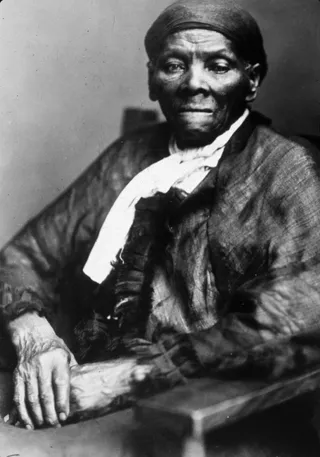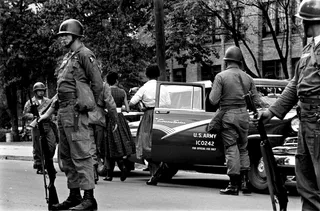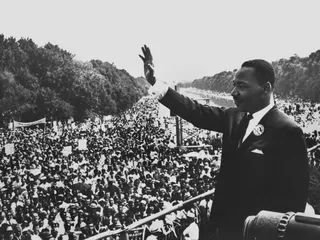20 Iconic Milestones in the Fight for Civil Rights
See how civil rights issues have evolved throughout history.

1 / 20
Making History - As civil rights leaders are set to mark the 50th anniversary of the March on Washington for Jobs and Freedom on Aug. 28, BET.com takes a look back at 20 major milestones that influenced the civil rights movement in America. — Britt Middleton (Photo: AP Photo/File)

2 / 20
The Abolitionist Movement: 1830-1870 - The abolitionist movement began, giving birth to the Underground Railroad (pioneered by Harriet Tubman), which transported more than 30,000 Black Americans from Southern slavery to Northern freedom. (Photo: MPI/Getty Images)
Photo By MPI/Getty Images

3 / 20
Dred Scott Decision - In 1857, the U.S. Supreme Court ruled that in the case of Dred Scott v. Sandford, also known as the "Dred Scott Decision," that all people of African descent — whether they were slaves or free — were not citizens of the United States and therefore could not sue for their freedom in federal court. While Scott, a slave and plaintiff in the case, was unsuccessful, less than 10 years later the Thirteenth Amendment of the U.S. Constitution officially abolished slavery and the Fourteenth Amendment granted citizenship rights to former slaves in 1868. (Photo: Hulton Archive/Getty Images)

4 / 20
Niagara Plants the Seeds for the NAACP - The Niagara Movement, a pre-cursor to the National Association for the Advancement of Colored People (NAACP), was formed in 1905. Today, the NAACP is the nation's oldest and largest grassroots civil rights organization. (Photo: Courtesy NAACP)

5 / 20
Jackie Robinson Breaks Racial Barriers in Baseball - Signing with the Brooklyn Dodgers in 1947, Jackie Robinson became the first African-American player in Major League Baseball, opening the door for other African-Americans to follow. (Photo: Sporting News via Getty Images)
ADVERTISEMENT

6 / 20
Integration of the U.S. Military - While African-Americans served in battles ranging from the American Revolution to World War II, a longstanding policy of segregated regiments for Blacks and whites remained through the 1940s. In 1948, President Harry Truman signed executive Order No. 9981, providing for "equality of treatment and opportunity in the armed forces without regard to race, color, religion, or national origin." (Photo: Archive Photos/Getty Images)

7 / 20
Brown v. Board of Education - The landmark U.S. Supreme court decision known as Brown v. Board of Education (1954) outlawed segregation in public schools. It overruled precedent set by Plessy v. Ferguson (1896), which upheld state-sponsored segregation under "separate but equal" doctrine. (Photo: Courtesy National Park Service)

8 / 20
Emmett Till - Emmett Till, a Black teen visiting relatives in Mississippi, was kidnapped and brutally murdered by two white men on Aug. 28, 1955. An all-white jury acquitted the men in September 1955, spurring international outcry that would help fuel the civil rights movement in the South. (Photo: Scott Olson/Getty Images)

9 / 20
Montgomery Bus Boycott - On Dec. 5, 1955, Rosa Parks, a 42-year-old seamstress, was arrested after she refused to give up her seat to a white man on a Montgomery, Alabama, bus. Her arrest galvanized civil rights advocates and launched a boycott of the Montgomery City bus system lasting 381 days, resulting in the desegregation of the city's buses in 1956. (Photo: Underwood Archives/Getty Images)

10 / 20
Southern Christian Leadership Conference (SCLC) - Following the Montgomery Bus Boycott, a group of civil rights leaders, including Martin Luther King Jr., convened in 1957 to form a regional civil rights organization and to coordinate demonstrations. The Southern Christian Leadership Conference was born, with King serving as its first president. (Photo: Birmingham News /Landov)
ADVERTISEMENT

11 / 20
“Little Rock Nine” - On Sept. 24, 1957, President Dwight D. Eisenhower ordered units of U.S. Army’s 101st Airborne Division to escort nine Black students, nicknamed the "Little Rock Nine," into the previously all-white Central High School in Little Rock, Arkansas. In the weeks before, the students were refused entry by the Arkansas National Guard and mobs of segregationists gathered to block the doors, abusing the Black teens with obscenities and death threats. (Photo: Lloyd Dinkins/Commercial Appeal /Landov)
Photo By Lloyd Dinkins/Commercial Appeal /Landov

12 / 20
Woolworth Lunch Counter - In February 1960, four African-American college students were refused service at the "whites only" lunch counter of Woolworth’s store in Greensboro, North Carolina. They launched a sit-in to protest the discriminatory policy, which inspired other non-violent demonstrations around the country. After nearly six months, the Woolworth's chain of stores integrated its lunch counters. (Photo: Wikicommons)

13 / 20
The March on Washington - An estimated 250,000 people gathered at the Lincoln Memorial to witness Martin Luther King Jr. deliver his historic "I Have a Dream" speech on Aug. 28, 1963. Supporters were taking a stand for civil and voting rights for minorities. (Photo: dpa /Landov)
Photo By Landov

14 / 20
Civil Rights Act of 1964 - The Civil Rights Act, introduced by President John F. Kennedy, legally ended discrimination in schools, public places and offices, in 1964. Sadly, Kennedy's assassination in 1963 would prevent him from seeing the measure come to fruition. It was signed into law on July 2, 1964, by President Lyndon Johnson. (Photo: Courtesy Library of Congress)

15 / 20
Selma-to-Montgomery March - On March 7, 1965, some 600 protesters embarked on the 54-mile march from Selma, Alabama, to the state capitol of Montgomery in support for voting rights for Blacks. As they reached the Edmund Pettus Bridge, state troopers attacked them with billy clubs and tear gas, in an event known as "Bloody Sunday." Under the protection of a U.S. National Guard convoy, an estimated 25,000 demonstrators peacefully arrived in Montgomery on March 25, 1965, giving way to the signing of the Voting Rights Act of 1965. (Photo: William Lovelace/Express/Getty Images)
ADVERTISEMENT

16 / 20
Voting Rights Act of 1965 - Signed by President Lyndon B. Johnson on Aug. 6, 1965, the Voting Rights Act of 1965 prohibited discriminatory voting practices adopted in many Southern states after the Civil War, including poll taxes, literacy tests and other measures meant to deny African-Americans the right to vote. A recent ruling by the United States Supreme Court invalidated a key section requiring nine states to have federal approval before changing their voting laws and regulations. (Photo: Cecil Stoughton/ White House Press Office)

17 / 20
Million Man March - Minister Louis Farrakhan and Benjamin Chavis made good on their plans to bring one million Black men to the National Mall in Washington on Oct. 16, 1995, marking a clear victory for positive change during a decade riddled by Black-on-Black violence, unemployment and drug abuse in Black communities nationwide. (Photo: Yoke Mc / Joacim Osterstam/WikiCommons)

18 / 20
James Byrd Jr. - In what was called one of the most notorious hate crimes of modern times, James Byrd Jr., 49, was murdered by three white supremacists in Jasper, Texas, in 1998. Offering Byrd a ride home, the men instead drove to a remote country road, beat him, chained his legs to the back of their pick-up truck and dragged him for several miles. In 2009, President Obama signed The Matthew Shepard and James Byrd Jr. Hate Crimes Prevention Act, strengthening hate crime prosecutions nationally. (Photo: Reuters /Landov)

19 / 20
Barack Obama Makes History - Then-Sen. Barack Obama of Chicago enchanted Americans with his message of positive change for all Americans and went on to be elected the 44th president of the United States on Nov. 4, 2008. Making history as the nation's first African-American president, Obama was re-elected to a second term in 2012. (Photo: Mark Wilson/Getty Images)
